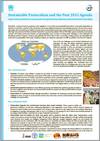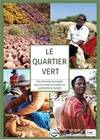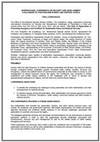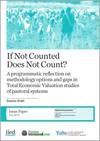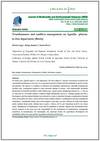Rangelands are large natural landscapes that can include grasslands, shrublands, savannahs and woodlands. They are greatly influenced by, and often dependent on, the action of herbivores. In the majority of rangelands the dominant herbivores are found in domestic herds that are managed by mobile pastoralists. Most pastoralists manage their rangelands communally, benefitting from the greater flexibility and seasonal resource access that common property regimes can offer. As this book shows, this creates a major challenge for governance and institutions.
Year of publication: 2014Organization: Union internationale pour la conservation de la nature (IUCN)
Topic: Régime foncier, Organisation
Language: English
Type of document: Technique
Geographical coverage: Global
The Post-2015 Agenda provides an opportunity to work globally towards making livestock production systems more sustainable while finding solutions for the conservation and sustainable use of ecosystems such as rangelands. This fact sheet presents overlooked facts, myths and emerging issues regarding pastoralism and gives recommendations on how to work towards sustainable pastoralism.
Year of publication: 2014Organization: Union internationale pour la conservation de la nature (IUCN), Programme des Nations Unies pour l'environnement (UNEP)
Topic: Économie, Services environnementaux, Participation
Language: English
Type of document: Technique
Geographical coverage: Global
What is the magnitude of pastoralism? The issue of the social and economic importance of pastoral systems is closely related with policies of land use. Overestimating the importance of pastoral systems, or downplaying it, can slow down development and lead to undesirable consequences. This study looks at the demand, the supply, and the future concerning data on the magnitude of pastoral systems in Kenya.
Year of publication: 2014Organization: , Auteurs individuels
Topic: Économie
Language: English
Type of document: Scientifique
Geographical coverage: Afrique orientale
L'Initiative Mondiale pour un Pastoralisme Durable (IMPD) a été en existence depuis une décennie, une période au cours de laquelle des progrès considérables ont été accomplis au niveau mondial en faveur du développement pastoral durable. De nombreux défis restent à relever pour les éleveurs, mais dans les zones où les gains ont été faits il est essentiel ceux-ci sont construits sur et les réalisations ne sont pas gaspillées. Ce livre suit l'approche globale de WISP et met en évidence des exemples clés de son travail avec des partenaires du monde entier. Il identifie l'impact du travail de l'IMPD dans l'autonomisation des éleveurs grâce à l'amélioration des capacités de plaidoyer et une meilleure connaissance, et pour aider à changer la politique et la pratique. Grâce à des études de cas, des témoignages et des photos, ce livre vise à apporter des histoires globales du pastoralisme de l'IMPD à un large public et identifier les opportunités pour le succès futur.
Year of publication: 2014Organization: Union internationale pour la conservation de la nature (IUCN)
Topic: Changement climatique, Économie, Services environnementaux, Résilience
Language: English, Français
Type of document: Technique
Geographical coverage: Global
Key stakeholders that included the pastoralists, farmers, and other natural resource users, civil society, the academia, key government agencies, faith-based organizations, the media and security agencies discussed and proffered lasting solutions to the security challenges associated with pastoralism in countries and across the region, to promote the improvement of pastoral production systems.
Year of publication: 2014Organization: Auteurs individuels
Topic: Conflit, Organisation
Language: English
Type of document: Politiques et législation
Geographical coverage: Afrique occidentale, Afrique centrale
The country report presents an analysis of changing policy narratives about the arid and semi-arid lands in Kenya. Kenya cannot achieve its development targets unless there are appropriate investments in the arid and semi-arid lands. These lands can make a significant contribution to national development and the failure to integrate them into the national economy is perhaps being the main reason for the failure of national development since independence. Investing in the arid lands is now a constitutional imperative and the institutional foundations for their integration into national development are now in place.
Year of publication: 2014Organization: Institut international pour l'environnement et le développement (IIED)
Topic: Changement climatique, Économie, Services environnementaux, Résilience
Language: English
Type of document: Technique
Geographical coverage: Afrique orientale
The substantial value of pastoral systems remains largely invisible to local, national and regional calculations of economic performance (for example the construction of GDP). Official data continue to be used even when their reliability is known to be poor. A complementary framework in cost-benefit analysis, known as Total Economic Valuation, is increasingly being used by NGOs and regional bodies to help put onto the map the many aspects of economic value contributed by pastoral systems– contributions that are presently not counted. This issue paper provides a practical tool for those interested in carrying out work on the Total Economic Valuation of pastoralism.
Year of publication: 2014Organization: Institut international pour l'environnement et le développement (IIED)
Topic: Économie
Language: English
Type of document: Technique
Geographical coverage: Afrique orientale, Global
For thirty years, Agonlin region in Zou department has been subject to extensive movements of national and cross-border transhumance every year: it is a seasonal movement of flocks and their shepherds in search of water and pastures. The absence or weakness of structures and hospitality infrastructure, especially transhumance corridors lead transhumant animals to cause enormous damage to farmers with immeasurable drawbacks (destruction of crop fields and fallows, cattle raiding crops , raping women, slaughtering animals, etc.)
Year of publication: 2014Organization: Auteurs individuels
Topic: Conflit, Peuples autochtones, Organisation
Language: English
Type of document: Technique, Scientifique
Geographical coverage: Afrique occidentale



